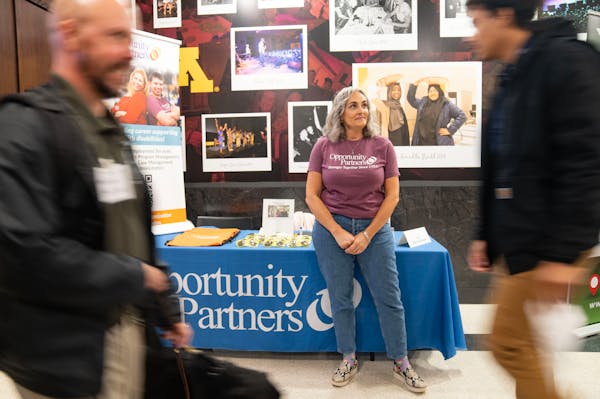More Minnesota nonprofits are facing financial crises than any year since 2020 as many continue to weather rising expenses amid stagnant or declining donations.
Nearly 80% of nonprofits in a new statewide survey reported that they have less than 12 months before they face financial distress — an increase from last year when nearly two-thirds of nonprofits said the same. In 2021 and 2022, about half of nonprofits said they had less than a year before they'd be struggling financially.
"It's an alarming number," said Kari Aanestad, associate director at the Minnesota Council of Nonprofits, which started surveying the conditions facing the sector in May 2020, when 81% of nonprofits said that they had less than a year until facing financial distress. "Nonprofits touch the lives of every single Minnesotan, but many Minnesotans probably don't even realize it."
The new data, released by the statewide association Thursday, shows the slow recovery of Minnesota's nonprofit sector from the COVID-19 pandemic. In fact, more nonprofits may be hurdling toward a "financial COVID cliff" that experts warned about after extra pandemic-related federal grants ended and charitable giving waned following unprecedented levels of generosity.
"Are we at the COVID cliff or are folks falling off of it?" said Aanestad, who is tracking an uptick in the number of nonprofits going dormant or dissolving this year. "Even one group closing can have a significant impact on people and communities."
In October, HUGE Improv Theater in Minneapolis is closing after nearly two decades while Agate Housing and Services is shutting down a Minneapolis shelter, low-income housing and food shelf, and laying off 23 employees.
Earlier this year, Minneapolis media arts organization Pollen Midwest shuttered after 14 years. The Minnesota Historical Society in St. Paul, which manages museums and historic sites across the state, laid off seven employees. And Rainbow Health in Minneapolis, which advocated for LGBTQ patients, abruptly shut down.
All five organizations blamed financial troubles for cuts or closures.
Nonprofits — from small food shelves and theaters to massive health care organizations — make up about 14% of Minnesota's workforce, according to state data. They employ about 370,000 workers, down from a record 391,000 employees in 2019.
Many of those organizations fill gaps in government services, whether it's mental health help or food assistance, and are part of building the civic fabric of the state, Aanestad said.
"There's something bigger at stake," she said. "It impacts all of us."
Propel Nonprofits in Minneapolis, which helps nonprofits with finances and loans, has seen an uptick in requests for working capital loans to help sustain operating expenses, CEO Henry Jiménez said. It's essential state government, foundations and donors step up their support of nonprofits, he added.
"Everybody says Minnesota is the Land of 10,000 Lakes — and also 10,000 or so nonprofits," Jiménez added. "This is what makes Minnesota a beautiful place to live. We should continue to invest in the nonprofit sector."
In St. Paul, Neighborhood House is serving a record number of people this year at its free food markets and other programs. Food costs and other expenses continue to rise while the number of donations and volunteers lag, CEO Janet Gracia said. The organization will stave off layoffs or program cuts by dipping into its reserves.
"These are our neighbors," she said. "People should just be aware that nonprofits provide really important, essential services."
Rebuilding nonprofits
Since 2020, nonprofits have been strained. Many museums and cultural institutions are still rebuilding from COVID closures that tanked revenue and caused widespread layoffs and furloughs.
Meanwhile, social services nonprofits have scrambled to serve a record number of Minnesotans in need. The sector has also been hampered by a lack of volunteers and staffing shortages.
The Council of Nonprofits' survey found mounting pressures on organizations. Key results from the June survey of 225 nonprofits include:
- Charitable giving is stagnant or dropping: Most nonprofits reported that donations are either flat this year compared with last year, declining or are anticipated to decline. Aanestad said part of that could be from lingering public distrust in nonprofits after the Feeding Our Future fraud scandal, which centered on federally funded meal programs.
- Demand for programs and services has continued to grow: 73% report they've increased programs and services in the last year to meet the demands of Minnesotans — the highest percent since 2020. This shows that, even with the pandemic ending and the economy rebounding, many Minnesotans haven't fully recovered, Aanestad said.
- The rate of volunteers is flat: For more than half of nonprofits, the number of volunteers this year hasn't changed from 2023. That doesn't mean that nonprofits aren't still short the volunteers they need; in 2023, more than a third of nonprofits had seen a decline in volunteers from 2022. Of this year's respondents, 15% are experiencing or expecting to see a decline in volunteers.
Fewer volunteers are showing up to the Salvation Army this year. And while average donation amounts have gone up, the number of donors has dipped 9% from last year, a "bigger warning sign," said Paul Deakins, executive director of development at the Salvation Army Northern Division, which serves Minnesota and North Dakota.
He said the organization, which relies on grants and donations for a third of its revenue, won't fill some job vacancies to cut costs.
"We cannot do what we do without those that support us," he said.
Some nonprofits are getting creative with cost cutting, such as downsizing office space or splitting costs by merging or sharing services, such as a human resources department, Aanestad said.
Earlier this year, the Food Group, one of seven food banks in the state, merged with Hunger Solutions Minnesota, an advocacy organization. That cut some costs by not duplicating services and hopefully will help the New Hope nonprofit land more grants, which have become increasingly competitive, said Sophia Lenarz-Coy, its executive director. Extra state aid last year has also temporarily bolstered hunger relief organizations, but Lenarz-Coy said it's unclear if that level of state funding will continue.
"We all hold our breath to see where things shake out," Lenarz-Coy said. "There is still uncertainty."

Shocking aftermath of car crash revealed in Day 2 testimony in Derrick John Thompson trial
Assailant found not guilty because of mental illness in fatal stabbing at Minneapolis home

One side of Lowry tunnel on I-94 reopens 2 hours after semi hit wall and crashed
Minnesota cannabis agency agrees to settle canceled social equity license lottery case

